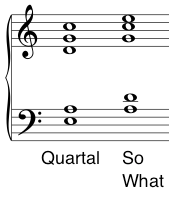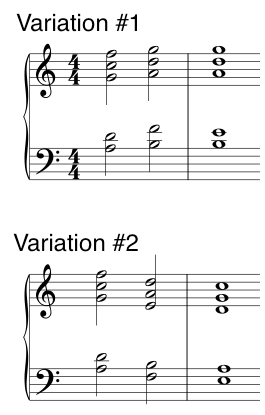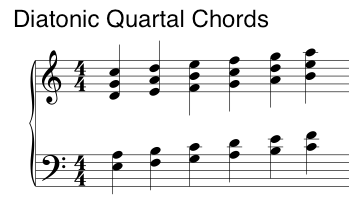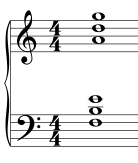Quartal Harmony
We have already briefly discussed Quartal Harmony in the lesson on the So What Chord. We established that, while chords are traditionally constructed in intervals of 3rds, it is also possible to build chord up in intervals of 4ths. These are called Quartal Chord Voicings.
A few points on Quartal chords:
- Building chords in 3rd is now considered old-fashioned and simplistic, while building in 4ths is considered much more sophisticated and ‘modern’.
- Quartal Chords are very ambiguous (there is no clear tonal centre [root note] and each voicing can be many different chords).
- Because Quartal Chords are built in 4ths, they have a slightly Suspended Chord sound.
- Because Quartal Chords are ambiguous and sound suspended, they do not have the same need to resolve to any particular chord – they just float there as stand alone entities.
- Chords built in 4ths are analysed in the same way as regular chords built in 3rds. We look at all the notes that comprise them and figure out an appropriate chord name. (This is arguably unsuitable, because chords built in 4ths sound and function very differently to chords built in 3rds. But unfortunately, standard music theory is what everyone knows and uses).
- Standard Quartal Voicing use 5 notes – but this can be dropped to 4 or 3 or increased to 6 – and are generally played in the middle register of the piano.
Chord Ambiguity
Because of the way the Quartal Chords are constructed (4ths rather than 3rds), they are rather ambiguous and can be numerous chords at once, depending on the context. Some of these chords are listed below.
| Chord | E | A | D | G | C |
|---|---|---|---|---|---|
| C69 | 3 | 6 | 9 | 5 | 1 |
| FMaj13 | 7 | 3 | 13 | 9 | 5 |
| Am11 | 5 | 1 | 11 | ♭7 | ♭3 |
| D9sus | 9 | 5 | 1 | 4 | 7 |
| B♭Maj13#11 | #11 | 7 | 3 | 13 | 9 |
Quartal Chord Inversions
It’s interesting to note that a 1st inversion Quartal Chord is a So What Chord.
| Quartal | So What | Sheet Music |
|---|---|---|
| E-A D-G-C | A-D G-C-E |  |
Generic Quartal Chord Voicings
While a Quartal Chord can be a number of different chords, as outlined above, there are, nevertheless, Generic Quartal Chord Voicings which are widely used for particular chord types. These are shown below.
| Notes | Chord |
|---|---|
| E-A D-G-C | C69 |
| B-E A-D-G | CMaj9 |
| A-D G-C-F | Dm11 |
| B-F A-D-G | G9 |
| F-B E-A-D | G13 |
Using the above Generic Voicings, it is possible to play a Quartal II-V-I
| II-V-I in C | |||
|---|---|---|---|
| Basic Chord Progression | Dm7 | G7 | CMaj7 |
| Variation #1 | Dm11 | G9 | CMaj9 |
| A-D G-C-F | B-F A-D-G | B-E A-D-G | |
| Variation #2 | Dm11 | G13 | C69 |
| A-D G-C-F | F-B E-A-D | E-A D-G-C | |

Note: The interval B to F is an augmented 4th (tritone) and the interval F to A is a diminished 4th (Major 3rd).
In the same way that we can build regular tertian diatonic chords by walking up a scale (Cmaj7, Dm7, Em7, etc.) we can also do this with quartal diatonic chords.
If you’re using only the notes from a particular key, a Quartal Voicing can be any diatonic chord from that key, as long as it does NOT contain that chord’s Avoid Note. And you get a harmonically stronger chord if the voicing includes the Guide Tones (3rd & 7th) of that chord. Below is a graph demonstrating this.
| Notes | Missing Notes | Allowable Chords | Avoid Notes |
|---|---|---|---|
| EADGC | F & B | C69 Dm11 Am11 FMaj13 | Cmaj7 – F Dm7 – None Em7 – F and C Fmaj7 – None G7 – C G7sus - None Am7 – F Bø7 – C |
| FBEAD | G & C | G13 Bø7 Dm69 FMaj7#11 |
|
| GCFBE | A & D | G7sus FMaj7#11 |
|
| ADGCF | B & E | Dm11 F69 |
|
| BEADG | C & F | CMaj13 Em11 Bø7 FMaj13#11 |
|
| CFBEA | D & G | G7sus FMaj7#11 |
|
| DGCFB | E & A | G7sus FMaj#11 |

A similar exercise can be performed for 4 & 6 note Quartal chords.
One widely used 6 note Quartal Chord is the below Dominant Chord. This is a particularly good chord to use over a Blues.
- G13 = F-B-E A-D-G
- Notice the Avoid Note (C) is missing

Have a Listen to
- Impressions ~ John Coltrane
- My Favorite Things ~ John Coltrane
- Maiden Voyage ~ Herbie Hancock
- Now He Sings, Now He Sobs ~ Chick Corea
- Any and Every McCoy Tyner song